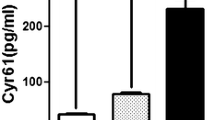Abstract
A pilot study was conducted to determine the concentrations of soluble serum E-cadherin in 36 patients with colorectal cancer or a high-grade dysplasia by the use of an ELISA technique. The results were compared with staging characteristics and concentrations of routine serum carcinoembryonic antigen (CEA). Sixteen patients with benign diseases and nine healthy volunteers served as internal or negative controls. Tumour specimens from seven patients were analysed by immunohistochemistry to compare concentrations of soluble serum E-cadherin with patterns of cell-bound E-cadherin or β-catenin. Serum E-cadherin concentrations were increased in colorectal cancer patients (P=0.009), but also in benign disease controls (P=0.005), correlating with the T- (P<0.05), but not N- or M-stage, and with serum CEA (P=0.002) in case of existing liver metastases. Compared with other staining patterns, concentrations of soluble serum E-cadherin were higher in case of an exclusive membrane-bound localization of cellular β-catenin (P=0.071). The results suggest marker characteristics of soluble serum E-cadherin in colorectal cancer patients, but lacking specificity argues against a routine clinical use.
Similar content being viewed by others
References
Kemler R. From cadherins to catenins: Cytoplasmic protein interactions and regulation of cell adhesion. Trends Genet 1993; 9: 317–21.
Steinberg MS, McNutt PM. Cadherins and their connections: Adhesion junctions have broader functions. Curr Opin Cell Biol 1999; 11: 554–60.
Adams CL, Nelson WJ.Cytomechanics of cadherin-mediated cell-cell adhesion. Curr Opin Cell Biol 1998; 10: 572–7.
Shimoyama Y, Hirohashi S, Hirano S et al.Cadherin cell-adhesion molecules in human epithelial tissues and carcinomas. Cancer Res 1989; 49: 2128–33.
Günthert U, Birchmeier W.Attempts to understand metastasis formation. Curr. Top. Microbiol. Immunol. 1996; 213/II: 117–35.
Banks RE, Porter WH, Whelan P et al.Soluble forms of the adhesion molecule E-cadherin in urine. J Clin Pathol 1995; 48: 179–80.
Griffiths TRL, Brotherick I, Bishop RI et al.Cell adhesion molecules in bladder cancer: Soluble serum E-cadherin correlates with predictors of recurrence. Br J Cancer 1996; 74: 579–84.
Katayama M, Hirai S, Yasumoto M et al.Soluble fragments of Ecadherin cell adhesion molecule increase in urinary excretion of cancer patients, potentially indicating its shedding from epithelial tumor cells. Int J Oncol 1994; 5: 1049–57.
Katayama M, Hirai S, Kamihagi K, Nakagawa K et al.Soluble Ecadherin fragments increased in circulation of cancer patients. Br J Cancer 1994; 69: 580–5.
Gofuku J, Shiozaki H, Doki Y et al.Characterization of soluble Ecadherin as a disease marker in gastric cancer patients. Br J Cancer 1998; 78: 1095–101.
Chan AOO, Lam SK, Chu KM et al.Soluble E-cadherin is a valid prognostic marker in gastric carcinoma. Gut 2001; 48: 808–11.
Pittard AJ, Banks RE, Galley HF, Webster NR.Soluble E-cadherin concentrations in patients with systemic inflammatory response syndrome and multiorgan dysfunction syndrome. Br J Anaesth 1996; 76: 629–31.
Matsuyoshi N, Tanaka T, Toda K et al.Soluble E-cadherin: A novel cutaneous disease marker. Br J Dermatol 1995; 132: 745–9.
Damsky CH, Richa J, Solter D et al.Identification and purification of a cell surface glycoprotein mediating intercellular adhesion in embryonic and adult tissue. Cell 1983; 34: 455–66.
Wheelock MJ, Buck CA, Bechtol KB, Damsky CH.Soluble 80-kd fragment of cell-CAM 120/80 disrupts cell-cell adhesion. J Cell Biochem 1987; 34: 187–202.
Benchimol S, Fuks A, Jothy S et al.Carcinoembryonic antigen, a human tumor marker, functions as an intercellular adhesion molecule. Cell 1989; 57: 327–34.
Wagener C, Müller-Wallraf R, Nisson S et al.Localization and concentration of carcinoembryonic antigen (CEA) in gastrointestinal tumors: correlation with CEA levels in plasma. J Natl Cancer Inst 1981; 67: 539–47.
Ikeda Y, Mori M, Kajiyama K, et al.Indicative value of carcinoembryonic antigen (CEA) for liver recurrence following curative resection of stage II and III gastric cancer. Hepato-Gastroenterol 1996; 43: 1281–7.
Wolmark N, Fisher B, Wieand HS et al.The prognostic significance of preoperative carcinoembryonic antigen levels in colorectal cancer. Ann Surg 1984; 199: 375–82.
TNM Classification of Malignant Tumours. 5th edition. New York: J Wiley & Sons 1997.
Schmit-Gräff A, Ertelt V, Allgaier H-P et al.Cellular retinol-binding protein-1 in hepatocellular carcinoma correlates with ?-catenin, Ki-67 index, and patient survival. Hepatology 2003; 38: 470–80.
Velikova G, Banks RE, Gearing A et al.Serum concentrations of soluble adhesion molecules in patients with colorectal cancer. Br J Cancer 1998; 77: 1857–63.
Author information
Authors and Affiliations
Corresponding author
Rights and permissions
About this article
Cite this article
Wilmanns, C., Grossmann, J., Steinhauer, S. et al. Soluble serum E-cadherin as a marker of tumour progression in colorectal cancer patients. Clin Exp Metastasis 21, 75–78 (2004). https://doi.org/10.1023/B:CLIN.0000017204.38807.22
Issue Date:
DOI: https://doi.org/10.1023/B:CLIN.0000017204.38807.22




